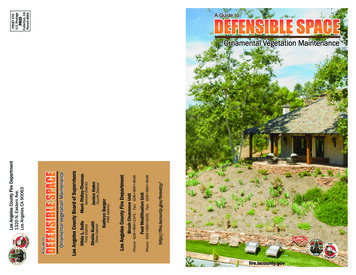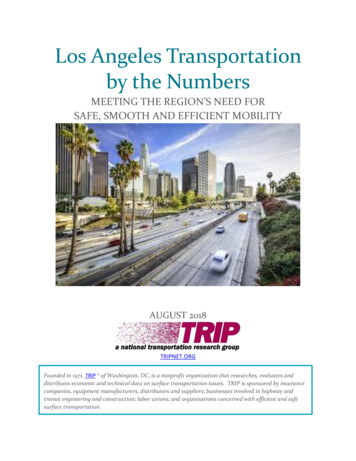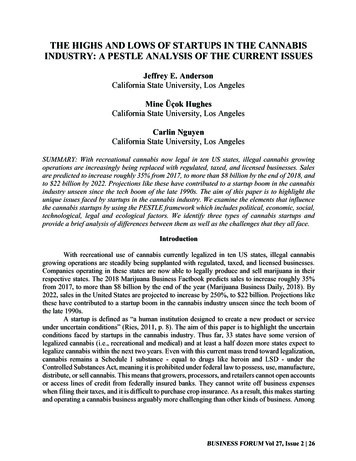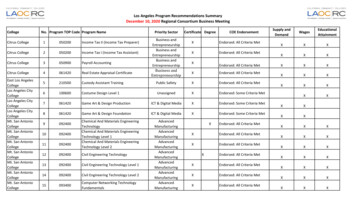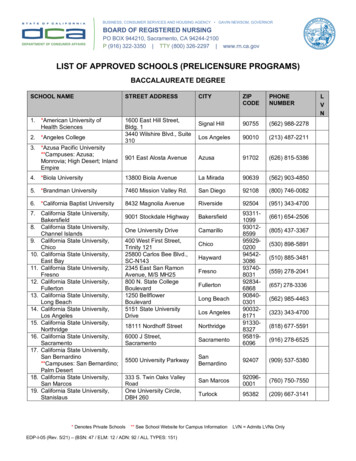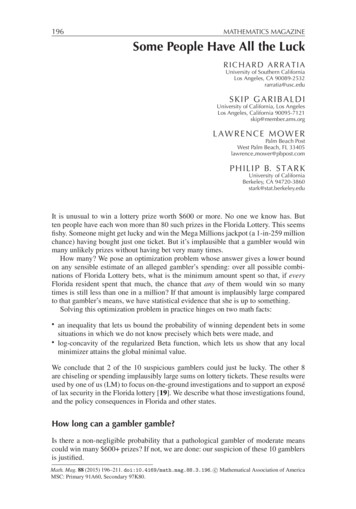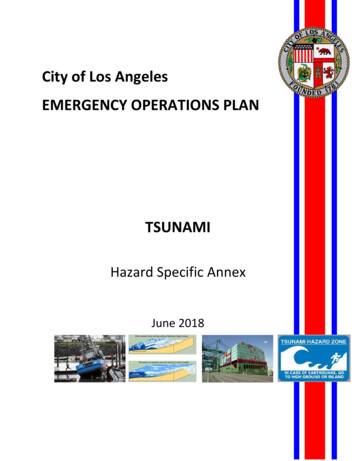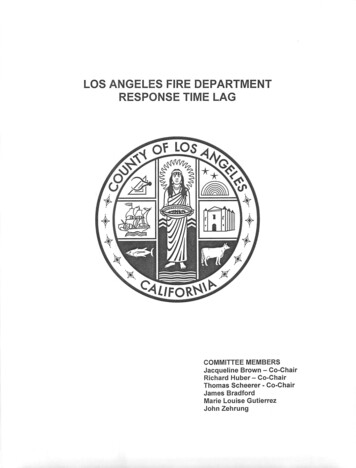
Transcription
LOS ANGELES FIRE DEPARTMENTRESPONSE TIME LAGCOMMITTEE MEMBERSJacqueline Brown — Co-ChairRichard Huber — Co-ChairThomas Scheerer - Co-ChairJames BradfordMarie Louise GutierrezJohn Zehrung
8. LOS ANGELES FIRE DEPARTMENT RESPONSE TIME LAGEXECUTIVE SUMMARYSeveral negative articles in various Los Angeles area newspapers regarding poor response timeto 9-1-1 medical emergency calls within the City of Los Angeles prompted this investigation'.A committee of the Los Angeles County Civil Grand Jury (Grand Jury) found that responsetimes in the Los Angeles Fire Department (LAFD) began to increase when its budget wasdecreased. The Grand Jury believes that the Los Angeles City Council may have relied oninaccurate response time data 2 in making its budget reduction decision. The Grand Jury alsofound that LAFD does not utilize its resources to its best advantage. To be specific, the GrandJury urges that LAFD's funding be restored, that its engine companies be reinstated, it incorporate civilian call handlers, use a non-proprietary Emergency Medical Dispatch protocol and update technical equipment.RECOMMENDATIONS8.1 The City of Los Angeles should reinstate the funding to the LAFD that was cut in 2008. lfrestoing some funding to LAFD, additional funding is crucial to place back into service the multiple engine companies' ambulances idled by previous budget cuts.8.2 LAFD should incorporate civilians as call handlers in its dispatch center. LAFD hastraditionally used sworn firefighters to answer 9-1-1 calls. Other local emergency responsedepartments use civilian call handlers with no apparent decline in service. This wouldprovide economic savings and allow sworn personnel to return to active emergency service.8.3 LAFD should use a customizable Emergency Medical Dispatch Protocol to allow for callhandler flexibility in responding to 9-1-1 calls.8.4 LAFD must update the technical equipment in its vehicles and dispatch center as outlinedin the November 2012 report from the task force on Information and Data Analysis (IDA).Technical innovations are also needed to reduce response times for the LAFD, such as thenew Smart911 4 system that has been implemented in other fire agencies.i hief-20121205,0,3100712.story2 ials-admit-to-exaggerating-response-stats3LA Times dated December 4, t?Query Smart911&target adv all2012-2013 Los ANGELES COUNTY CIVIL GRAND JURY REPORT63
LOS ANGELES FIRE DEPARTMENT RESPONSE TIME LAGMETHODOLOGYThe Grand Jury's Fire Dispatch Committee visited four different fire department emergencycenters: Los Angeles Fire Department (LAFD), Los Angeles County Fire Department (LACFD),Verdugo Fire Communications Center (VFCC), which serves thirteen separate fire agencies, andLong Beach Fire Department (LBFD). The Grand Jury also obtained response time data fromthese four agencies and the National Fire Protection Association (NFPA) standards foremergency medical response times, and attended a meeting of the Los Angeles City Councilwhich focused on the LAFD's response times. The Grand Jury also interviewed senior membersof each of the above four agencies as well as a senior leader of the union representing LosAngeles City firefighters. In addition the Grand Jury interviewed many call handlers andobserved their work in "real time".BACKGROUNDCommittee members met with senior leaders in the four largest fire departments/agencies in LosAngeles County and discussed their operations and response times. Each department or agencyreports response times differently but they have been simplified in the comparison chart below.Grand Jury members were also given a tour of their respective dispatch centers.1. Los Angeles Fire Department:a.Sworn fire fighters are trained as call handlers and rotated through the dispatchcenter. A call handler's shift is fifty-six hours; they sleep on site so as to beimmediately available should there be an unusual spike in calls, such as during amajor disaster.b.The Emergency Medical Dispatch Protocol to guide the dispatcher is availableboth in hard copy and on the computer. This script is proprietary and modificationor deviation from it is not permitted.c.Medical emergency calls are prioritized to determine whether to send anAdvanced Life Support (ALS) or Basic Life Support (BLS) unit.d.LAFD transports patients as needed to a medical facility.2. Verdugo Fire Communications Center:64a.Civilians are trained as call handlers and work a twelve hour shift.b.The Emergency Medical Dispatch Protocol to guide the dispatcher is both in hardcopy and on the computer. This script is customized by the medical staff, withinput from call handlers.c.Medical emergency calls are prioritized to determine whether to send an ALS orBLS unit.2012-2013 Los ANGELES COUNTY CIVIL GRAND JURY REPORT
LOS ANGELES FIRE DEPARTMENT RESPONSE TIME LAGd.Agencies affiliated with VFCC transport patients to a medical facility either withagency ambulances or by private contractors.3. Los Angeles County Fire Department:a.Civilians are trained as call handlers and work a twelve hour shift.b.The Emergency Medical Dispatch Protocol to guide the call handler is both inhard copy and on the computer. This script is customized by the medical staff,with input from call handlers.c.As soon as a call is determined to be a medical emergency, it is dispatched. Thecaller is advised that units are en route and the dispatcher stays on line to assist asneeded. Any update to the call is sent to the responding unit's terminal.d.LACFD transports patients to a medical facility through private contractors.4. Long Beach Fire Department:a.Civilians are trained as call handlers and work a twelve hour shift.b.The Emergency Medical Dispatch Protocol is on hard copy only. This script iscustomized by the medical staff with input from call handlers.c.Medical emergency calls are prioritized to determine whether to send an ALS orBLS unit.d.LBFD transports patients as needed to a medical facility.The following response time chart created by the Grand Jury, shows the various agencies. It isnoted that LAFD response time is six minutes, 47 seconds (6:47), which is one minute, 25seconds (1:25) to 28 seconds (:28) slower than the other agencies.Time OutTravel TimeTotal 4:466:05LBFD1:005:196:19NFPA1:005:006:00Time Out: From call received to dispatch of equipment.Travel Time: From dispatch to arrival on site. This includes turn-out time i.e.the time needed forfirefighters to dress and get equipment rolling.Total Time: Time from call being answered to equipment arriving on site.Times above are averages. Agencies leave out times that are far outside the norm (outliers).*Times based on Task Force IDA, dated 11/2/20122012-2013 Los ANGELES COUNTY CIVIL GRAND JURY REPORT65
LOS ANGELES FIRE DEPARTMENT RESPONSE TIME LAG**VFCC times shown are an average of all the thirteen affiliated agencies. Verdugo Fire has a"seamless" or "no borders" operation for fire and is working on a similar operation for medicalresponses.***LACFD times shown are for urban responseFINDINGSThe Grand Jury found that the LAFD's response time, as shown by the chart on the previouspage, is noticeably longer than the other agencies reviewed by the Grand Jury. The followingfactors, which apply to all fire agencies, hamper response times:1. All 9-1-1 calls go to the primary Public Safety Answering Point (PSAP), which is the localpolice agency (per state regulations), with the fire department being secondary. The primaryPSAP must transfer a fire/medical call to the secondary PSAP within thirty seconds(per NFPA guidelines). The primary dispatcher remains on the line to ensure that the call istransferred and that no police involvement is required.2. Language can be a major factor as there are up to one hundred different languages or dialectsspoken in LA County. According to all four fire agencies, an interpreter may have to bebrought on the line to assist.3. Cell phones, unlike hard-wired home or business phones, do not give an exact address, whichis a critical piece of information needed before dispatching a unit. Newer cell phones,equipped with GPS, can now be triangulated to give an approximate location. In the past allcell phone calls went to the California Highway Patrol (CHP); now with more modern technology, 9-1-1 calls go to the nearest 9-1-1 call center. The CHP should still receive calls ifthe caller is on a freeway, in close proximity to a freeway or the cell phone, for whateverreason, cannot be accurately triangulated.4. The caller's state of mind, possibly being in a state of hysteria, could hamper getting neededinformation. The human factor always plays a part, even something as simple as the callerbeing unsure as to his whereabouts or being able to give an accurate description of thesituation.5. A principal factor that produces poor response time is the on-going problem of budget cuts. 5Geographycnlsfteoim.Calsfrhycomunitewarodsmake it difficult for fire equipment to maneuver. If a caller lives in a relatively isolated location, response time is certain to be ocal/la-me-1205-lafd-chief-20121205662012-2013 Los ANGELES COUNTY CIVIL GRAND JURY REPORT
LOS ANGELES FIRE DEPARTMENT RESPONSE TIME LAGFINDINGS continuedFunding: Of the above factors, the most crucial and the most obvious impediment to adequateresponse times is the budget issue. Once funding of the LAFD was reduced, based in part onfaulty or outdated data, response times began to rise. Additionally, thirteen ambulances wereidled. It is a given that fewer resources would lead directly to increased response time. TheGrand Jury strongly recommends that previous LAFD budget cuts be fully restored. The GrandJury recognizes that the LAFD is currently planning a different, yet controversial solution. 6Civilian Call Handlers: The Grand Jury was impressed with the use by other large agencies inLos Angeles County of civilians to handle incoming 9-1-1 calls. LAFD has for many years usedsworn firefighter personnel for such duty. The Grand Jury recommends that this change. Firefighters should be fighting fires and responding to medical emergencies, not answering phonecalls. Moreover, the skill set needed to obtain information from a 9-1-1 caller is not the sameskill set as fighting a fire or giving emergency care. The Grand Jury believes it is a betterpractice to have trained civilians perform call handling functions. This would eliminate the needto rotate firefighters into the Dispatch Center. Further, call handlers should be given a dispatchprotocol to follow so that the necessary information is gathered, but that protocol should not be ahandicap. Dispatch call handlers should have flexibility in dealing with callers and should not besubject to discipline for deviating from a dispatch protocol.Technology: Improvements are needed in the technology used by the LAFD. These arementioned in detail by the Task Force that the LAFD commissioned in June of 2012. The GrandJury learned from several fire officials that the Computer Assisted Dispatch (CAD) is thirty yearsold. Hardware and software must be brought up to current technology levels. This technologycould include software like Smart911. The Smart911 system is designed to create a safety profilefor the household, such as medical conditions, mobility, etc. This profile would appear on thecall handler's screen, which could expedite response time by avoiding the need to ask certainquestions.Response Time Reports: Reports should be easy to read and understand. The Grand Jury wasgiven response times reports in various formats, some of which were confusing. The Grand Jurybelieves the general public would benefit by having these response times presented in asimplified form, similar to the above chart.6Los Angeles Times dated April 17, 2013 LAFD to shift staff to medical calls2012-2013 Los ANGELES COUNTY CIVIL GRAND JURY REPORT67
LOS ANGELES FIRE DEPARTMENT RESPONSE TIME LAGAnalysis: Notwithstanding the above criticisms and concerns, the area fire departments aredoing the job that is expected. Response times, though, can sometimes be a factor in thedifference between life and death. There have been cases where a person has died while waitingfor the medical personnel to arrive.' With more finding, idle ambulances can be put back intoservice and there can be an upgrade of technical equipment with a consequent reduction inresponse times. The Grand Jury acknowledges with great appreciation the dedication andcommitment of all emergency responders in Los Angeles County and hopes that responses to thisreport will result in an enhancement of their service to all members of our community.REQUIRED RESPONSESRecommendation Responding Agencies8.1City of Los Angeles8.2, 8.3, 8.4Los Angeles Fire DepartmentLIST OF ACRONYMSALSAdvance Life SupportBLSBasic Life SupportCADComputer Assisted DispatchCHPCalifornia Highway PatrolIDAInformation and Data AnalysisLACFDLos Angeles County Fire DepartmentLAFDLos Angeles Fire DepartmentLBFDLong Beach Fire DepartmentNFPANational Fire Protection AssociationPSAPPublic Safety Answering PointVFCCVerdugo Fire Communications Centerhttp://www.dailynews.cominews/ci ing-soccer682012-2013 LOS ANGELES COUNTY CIVIL GRAND JURY REPORT
A committee of the Los Angeles County Civil Grand Jury (Grand Jury) found that response times in the Los Angeles Fire Department (LAFD) began to increase when its budget was decreased. The Grand Jury believes that the Los Angeles City Council may have relied on inaccurate res
